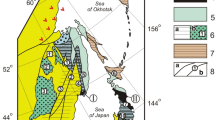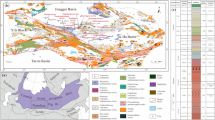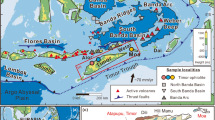Abstract
In Timor (Fig. 1) widespread outcrops of Cretaceous cherts belonging to the Wai Bua and Cretaceous Kolbano facies have been interpreted as deep-sea deposits that probably accumulated on the Australian continental rise1. I consider here another but less well known group of Cretaceous cherts exposed in Western Timor at the base of the Palelo Group, which outcrops in mountain massifs with metamorphic rocks of the Mutis Complex. Although the observed contacts between the two units are faulted2,3, the Palelo Group contains fragments of metamorphic rocks similar to those of the Mutis Complex4,5, suggesting an original unconformable relationship. Geochemical data6,7 from metasedimentary gneisses in the Boi Massif suggest that metamorphism occurred at pressures and temperatures likely to prevail deep in the continental crust. I suggest that the Cretaceous radiolarian cherts were deposited on a continental margin as the first sediments of a forearc basin. This is the first reported occurrence of radiolarian cherts deposited in this tectonic–sedimentary environment, and contrasts strongly with other Cretaceous radiolarian cherts exposed on the island. The evidence is crucial to understanding the tectonic evolution of the region because it is clear that the two groups of cherts were derived from different sides of the continent–island arc collision zone which makes up the Banda Arcs. The Palelo Group and the rocks it is associated with were derived from the South-east Asian side, which has had an active margin since at least the early Cretaceous.
This is a preview of subscription content, access via your institution
Access options
Subscribe to this journal
Receive 51 print issues and online access
$199.00 per year
only $3.90 per issue
Buy this article
- Purchase on Springer Link
- Instant access to full article PDF
Prices may be subject to local taxes which are calculated during checkout
Similar content being viewed by others
References
Carter, D. J., Audley-Charles, M. G. & Barber, A. J. J. geol. Soc. Lond. 132, 179–198 (1976).
Earle, M. M. thesis, Univ. London (1981).
Haile, N. S., Barber, A. J. & Carter, D. J. J. geol. Soc. Lond. 136, 65–70 (1979).
Tappenbeck, D. Geological Expedition Lesser Sunda Islands Vol. 1, 1–105 (University of Amsterdam, 1940).
West, F. P. Van. Geological Expedition Lesser Sunda Islands Vol. 3, 1–131 (University of Amsterdam, 1941).
Earle, M. M. Geol. Res. Devl. Centre, Bandung, Indonesia, Spec. Publ. 2, 239–251 (1981).
Brown, M. & Earle, M. M. J. met. Petrol. (in the press).
Earle, M. M. Nature 282, 375–378 (1979).
Voorthyusen, J. H. Geological Expedition Lesser Sunda Islands Vol. 2, 345–368 (University of Amsterdam, 1941).
Barber, A. J., Audley-Charles, M. G. & Carter, D. J. J. geol. Soc. Aust. 24, 51–62 (1977).
Grady, A. E. & Berry, R. F. J. geol. Soc. Aust. 24, 203–214 (1977).
Chamalaun, F. H. & Grady, A. E. J. Aust. Petrol. Explor. Ass. 18, 102–108 (1978).
Sugisaki, R., Yamamoto, K. & Adachi, M. Nature 298, 644–647 (1982).
Author information
Authors and Affiliations
Rights and permissions
About this article
Cite this article
Earle, M. Continental margin origin for Cretaceous radiolarian cherts in Western Timor. Nature 305, 129–130 (1983). https://doi.org/10.1038/305129a0
Received:
Accepted:
Issue Date:
DOI: https://doi.org/10.1038/305129a0
Comments
By submitting a comment you agree to abide by our Terms and Community Guidelines. If you find something abusive or that does not comply with our terms or guidelines please flag it as inappropriate.



